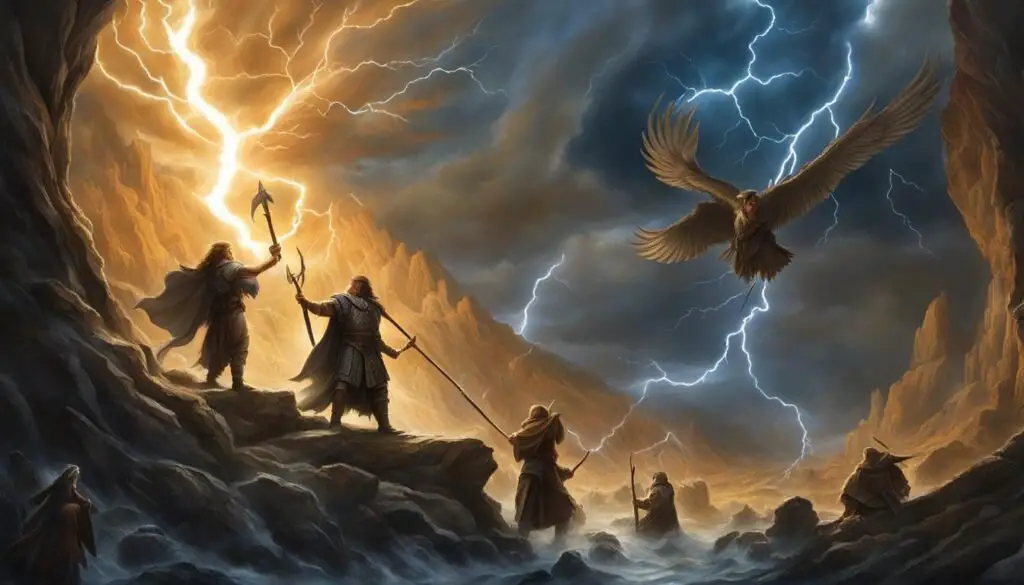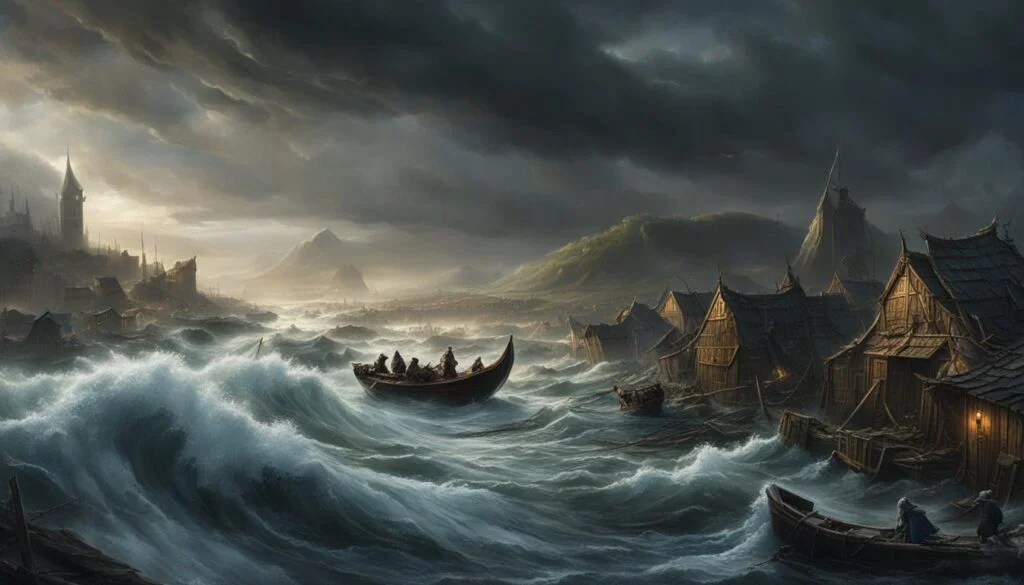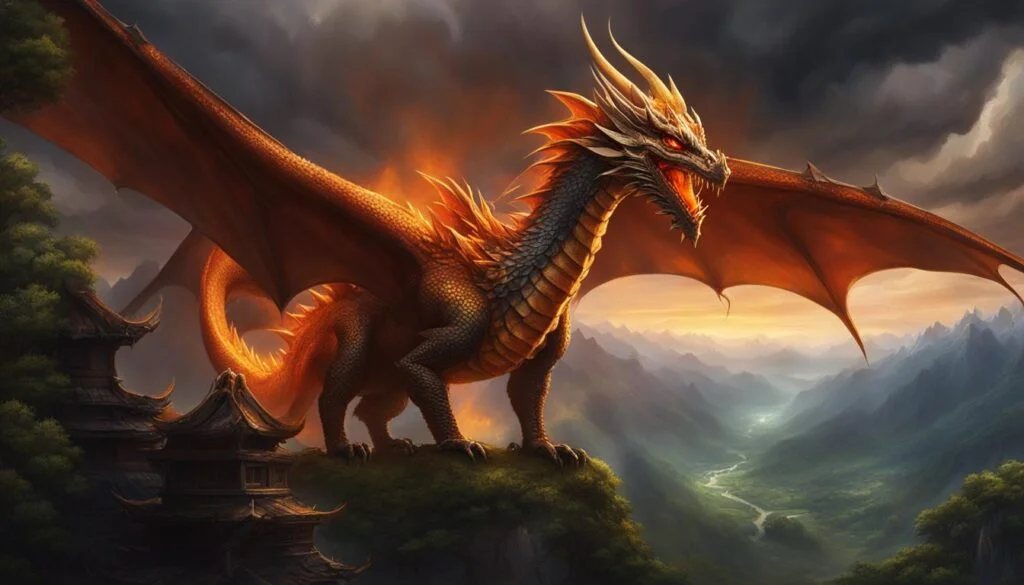Norse mythology has a captivating creation story that sheds light on the origin of humanity. In this fascinating myth, humans were not simply born but rather created by the gods themselves. The tale of Ask and Embla, the first humans in Norse mythology, holds deep significance and reflects the beliefs and values of ancient Norse culture.
The creation of humans in Norse mythology is a unique concept. Unlike other myths where humans are descendants of gods or emerge spontaneously, Ask and Embla’s creation has a distinct and symbolic essence. According to ancient texts, Ask and Embla were formed from two pieces of driftwood found on the beach.
Key Takeaways:
- The first humans in Norse mythology, Ask and Embla, were created by the gods Odin, Vili, and Ve.
- Ask and Embla represent the beginning of the three classes of men in Norse society.
- Their creation from the driftwood signifies the unique and symbolic nature of human existence in Norse mythology.
- The tale of Ask and Embla provides insights into the purpose and significance of human life in Norse culture.
- The creation story in Norse mythology shares parallels with other creation myths, suggesting universal human themes.
The Purpose of Ask and Embla
In Norse mythology, the creation of humans is a captivating tale that serves as a mythological explanation for human existence in Norse culture. Ask and Embla, the first humans, were not gods or giants, but ordinary individuals like us. However, their origin story is far from ordinary.
The divine trio of Odin, Vili, and Ve played a vital role in creating Ask and Embla as part of the larger Norse creation myth. This myth not only addresses the origins of humanity but also provides a foundation for the later three classes of men in Norse society.
Ask and Embla’s creation myth highlights the distinctive mythological belief system in Norse culture. Through this tale, the ancient Norse people sought to understand the purpose of human life, the role of gods, and the intricate connections between humans and the divine.
The Creation of Ask and Embla
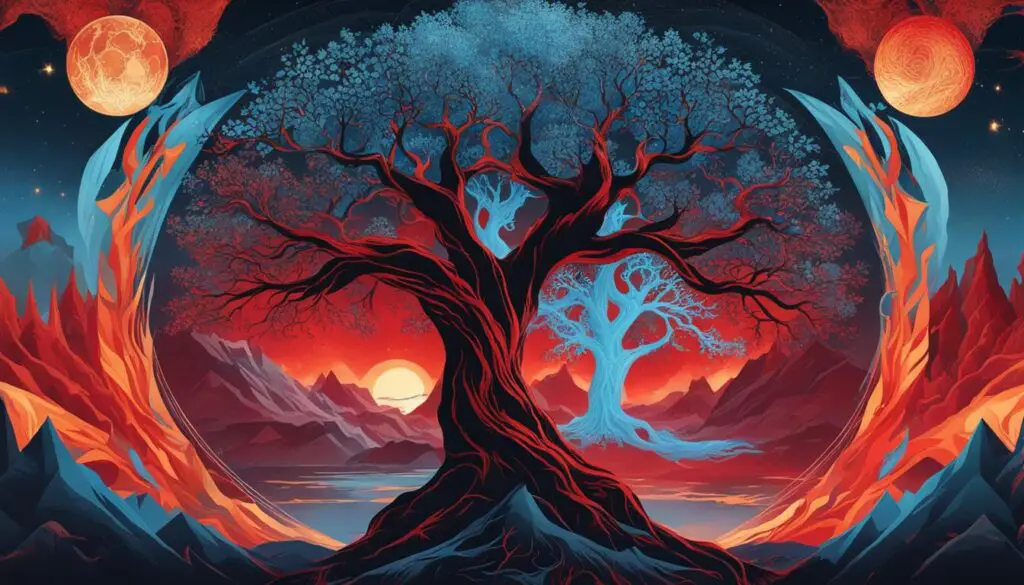
In ancient Nordic beliefs about human origins, Norse gods played a central role in the creation of humans. According to the ancient texts of the Poetic Edda and the Prose Edda, Ask and Embla, the first humans, were created from two trees.
Ask, the male human, was made from an ash tree, while Embla, the female human, was made from an elm tree. These two trees held great symbolic significance in Norse mythology, with the ash tree representing Yggdrasil, the cosmic tree that connected the different realms of existence.
It was Odin, the chief god, along with his brothers Vili and Ve, who breathed life into these wooden forms. They bestowed upon Ask and Embla the gifts that make humans distinct, including consciousness, intelligence, and humanity.
This creation myth emphasizes the intimate connection between nature, divinity, and humanity in ancient Norse beliefs.
Parallels with other Creation Myths
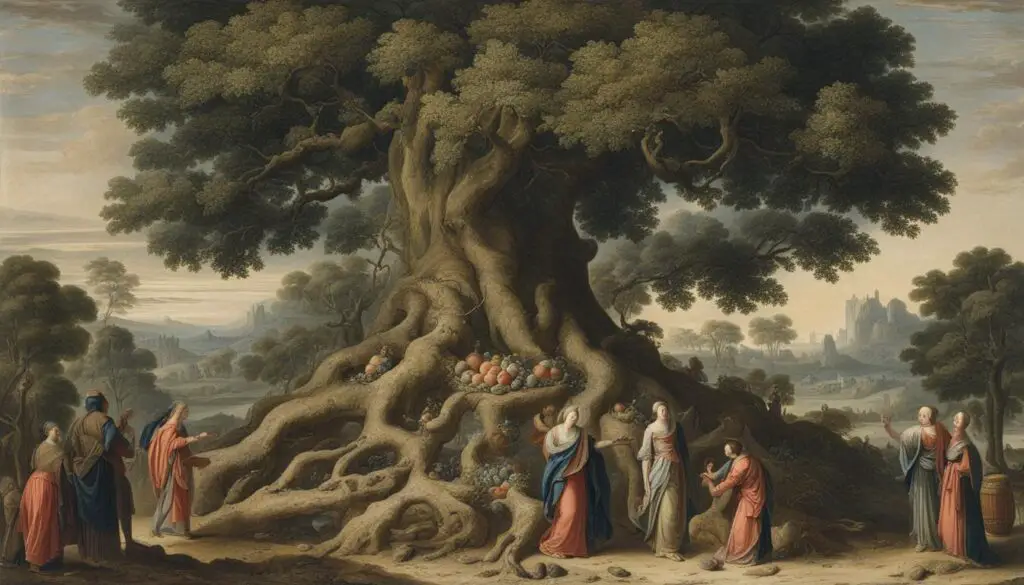
The story of Ask and Embla in Norse mythology shares similarities with other creation myths from different cultures. In the Judeo-Christian tradition, Adam and Eve are the first humans created by God. Like Ask and Embla, they were given life and endowed with unique gifts. Greek mythology also features the creation of the first woman, Pandora, who received gifts from the gods.
These parallels suggest a shared cultural heritage or universal human themes. The purpose of human life, as depicted in Norse mythology, intertwines with the concept of creation in many other cultures. It reinforces the idea that humanity’s existence and purpose have been debated and pondered throughout time.
Exploring the connections between different creation myths brings to light the shared beliefs and values that humans across cultures have held. These stories speak to our collective pursuit of understanding the mysteries of our origins and the purpose of our existence.
The Norse Creation Myth: Ginnungagap and Niflheim
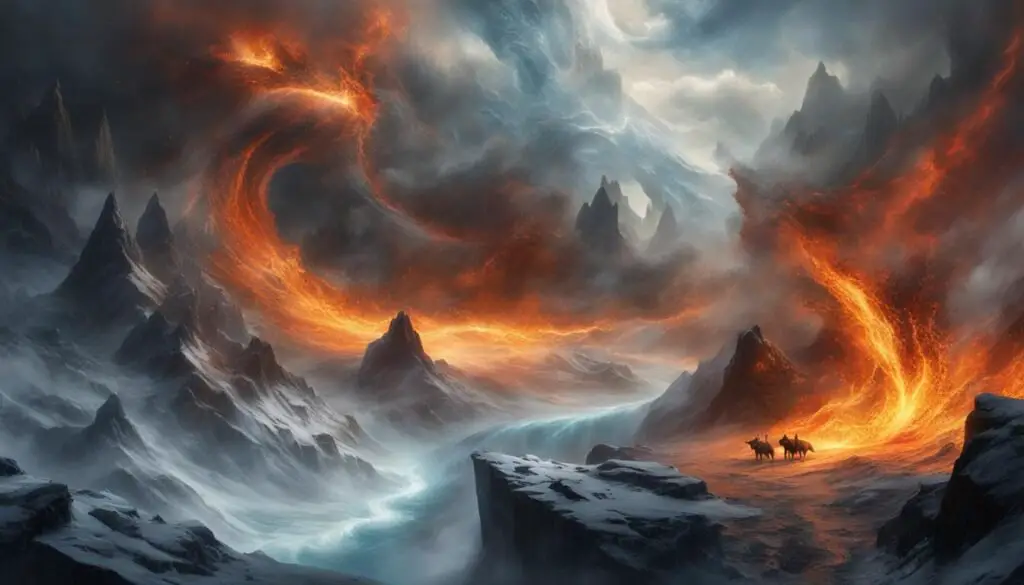
The Norse creation myth begins with the existence of Ginnungagap, a void of darkness. Two realms emerge from this void: Niflheim, the realm of frost and ice, and Muspelheim, the realm of fire and heat. Niflheim gives birth to the giant Ymir, who becomes the progenitor of all giants. This sets the stage for the creation of humans by the gods.
The Creation of Earth and the Giants
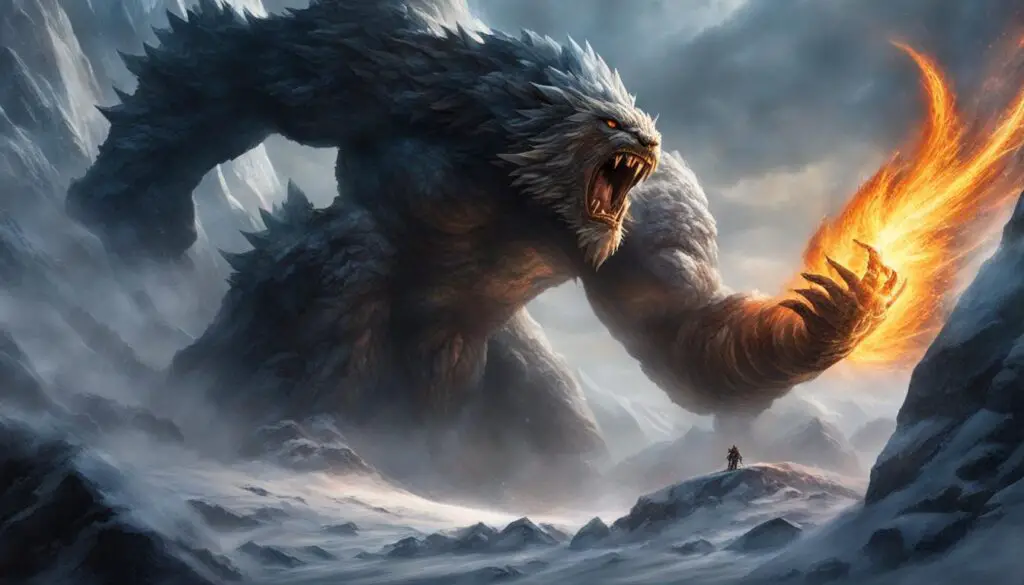
In ancient Nordic beliefs, the creation of the Earth and the emergence of the giants played a significant role. According to Norse mythology, the first giant, Ymir, came into existence when the primordial forces of ice and fire met in Ginnungagap. From this union, Ymir gave birth to various beings, including the first giants who would shape the world as we know it.
A pivotal figure in the Norse creation myth is the cow named Audhumbla. Audhumbla sustained the giants by providing them with nourishing milk. But it was through her strange and intriguing behavior that the seeds of humanity were sown.
One day, while roaming through the frozen wasteland, Audhumbla stumbled upon a salty block of ice. Curiosity got the better of her, and she began licking the ice block incessantly. After some time, her determined efforts revealed a surprising outcome: the emergence of the first human named Buri.
This mythical tale symbolizes the complex cycle of life and creation in ancient Norse beliefs. The Norse gods, with their intricate interactions and connections to the natural world, were believed to be the architects of human existence. Through the meeting of ice, fire, and the nurturing powers of Audhumbla, human life sprung forth, continuing the cosmic order devised by the gods.
In the next section, we will explore how the gods, humans, and the building of Asgard shaped the Norse cosmos.
Gods, Humans, and the Building of Asgard
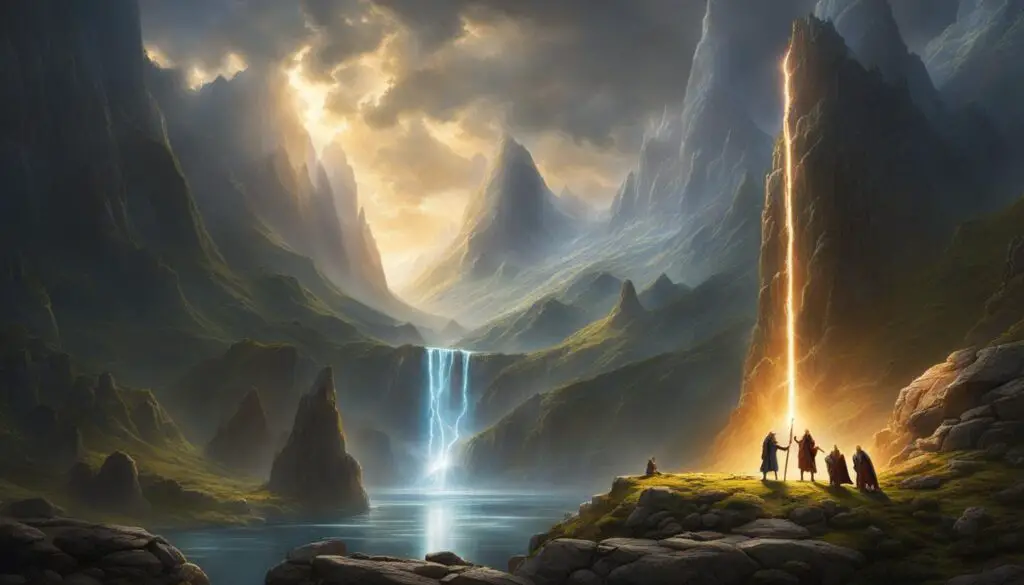
In Norse mythology, the creation of humans is closely intertwined with the gods and the establishment of Asgard as their stronghold. It all begins with Buri, the first god, who marries Bestla, the daughter of a giant. Together, they have three sons: Odin, Vili, and Ve.
Odin, Vili, and Ve are central figures in Norse mythology, along with the other Aesir gods. Together, they create a divine realm known as Asgard, where they reside as rulers. Odin, in particular, ascends to the position of the ruler of the gods, known for his wisdom, knowledge, and leadership.
This divine trio plays a pivotal role in the creation and development of the Norse cosmos. They shape the world, establish the realms of gods and humans, and oversee the order and balance of the universe. Their influence extends beyond the physical realm, as they also guide and shape the purpose of human life.
The Role of Dwarves in Creation
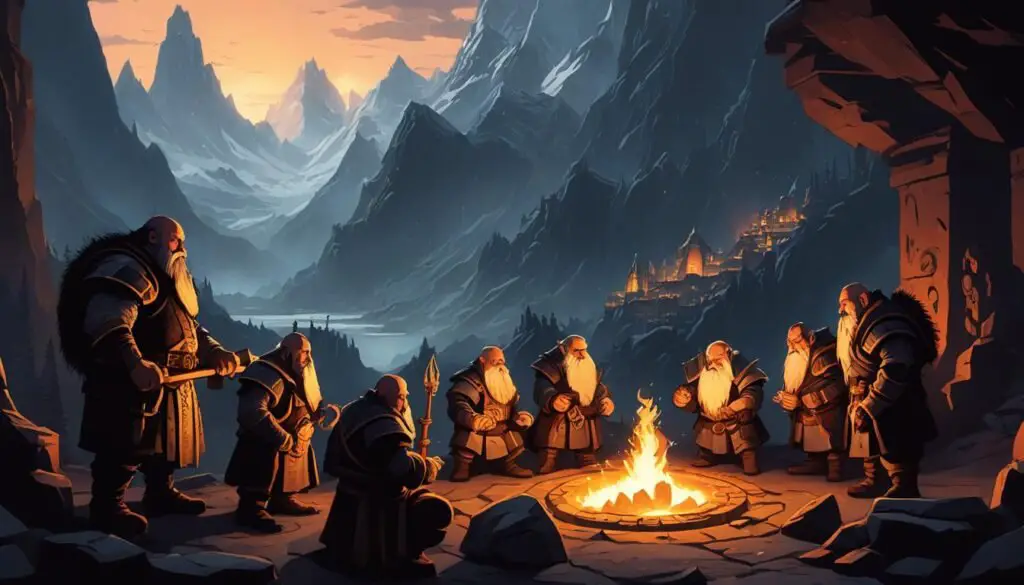
In ancient Nordic beliefs about human origins, Norse mythology plays a prominent role. Within this mythological framework, dwarves hold a significant position, known for their exceptional craftsmanship and unique contributions to the creation of the world. According to Norse mythology and human creation, dwarves emerged from maggots that originated from the decaying flesh of Ymir, the first giant.
The role of dwarves in Norse creation myth extends beyond their origin story. Four dwarves have the extraordinary responsibility of supporting the sky, while others dwell within rocks and caves. These industrious beings are revered for their ability to create powerful and important items, one of which is Thor’s renowned hammer, Mjolnir.
Central to the ancient Nordic beliefs about human origins, the presence and contributions of dwarves in Norse mythology are an essential part of understanding the intricate tapestry of creation within this mythological tradition.
The Master Craftsmen
- Dwarves are known for their exceptional craftsmanship.
- They emerged from maggots that originated from Ymir’s decaying flesh.
- Four dwarves support the sky, while others reside in rocks and caves.
- They produce important items such as Thor’s hammer, Mjolnir.
Creation of the Sun and Moon
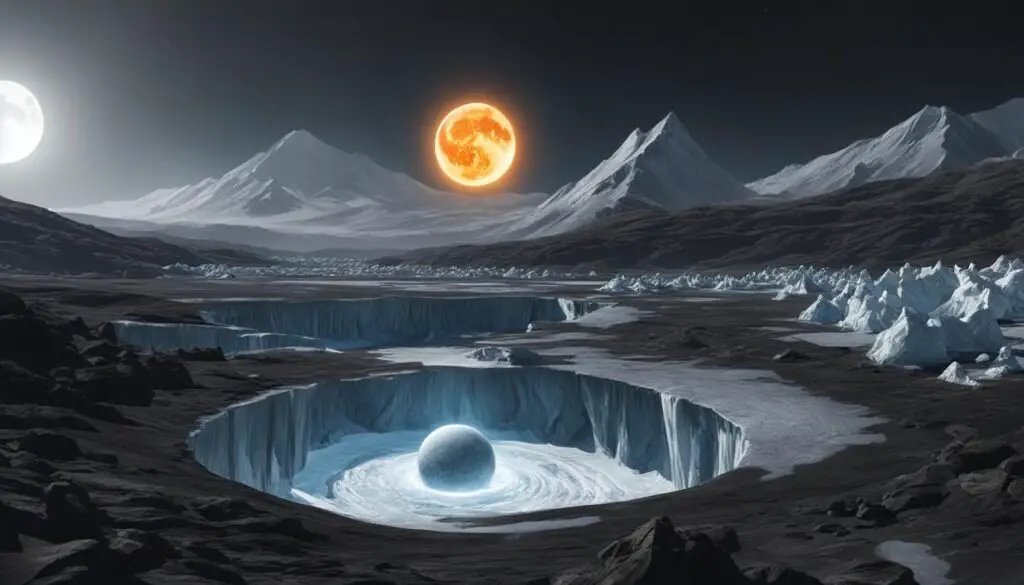
In Norse mythology, the gods play a vital role in the creation of the celestial bodies – the sun, moon, and stars. These celestial entities provide light, warmth, and guidance for the newly formed world.
The sky itself is formed from the severed head of Ymir, the first giant. As the gods fashioned the world from his remains, they used Ymir’s colossal head to create the expansive sky. The clouds, on the other hand, are said to be made from the brains of Ymir, enhancing the atmosphere with their ethereal presence.
The stars and burning embers that fill the night sky are born from the sparks of Muspelheim, the realm of fire and heat. The gods harness these fiery fragments to illuminate the vast expanse, creating a celestial tapestry that captivates the eyes and imaginations of humans.
The creation of the sun and moon holds great significance in Norse mythology. The sun becomes a symbol of warmth, light, and vitality, and is essential for sustaining life on Earth. The moon, on the other hand, guides the night, casting its gentle glow and serving as a beacon for travelers.
This celestial creation not only adds beauty and wonder to the Norse cosmos but also reinforces the purpose of human life. In the grand tapestry of existence, the presence of the sun and moon reminds us of the eternal cycles, the passage of time, and the need for balance in our own lives.
Conclusion
The Norse creation myth provides a captivating and intricate story that offers insight into the origins of humanity and the universe. At the heart of this myth are the first humans, Ask and Embla, who were created by the gods Odin, Vili, and Ve. This creation story, deeply rooted in Norse mythology, not only offers an explanation for human existence but also reflects the beliefs, values, and worldview of the ancient Norse people.
The tale of Ask and Embla serves as a foundational piece of Norse culture, shedding light on the purpose of human life in Norse mythology. By being fashioned from the elements of nature, Ask and Embla are intricately tied to the natural world and its divine origins. Their creation symbolizes the interconnectedness between humans and the cosmic forces at play in Norse cosmology.
Through the lens of Norse mythology, the purpose of human life is intertwined with the larger story of the gods, giants, dwarves, and the creation of the universe. The Norse people saw themselves as active participants in the ongoing cosmic drama, with their actions and choices shaping the fate of the world. This belief system instilled a sense of responsibility and agency in individuals, reinforcing the idea that each person had a role to play in the grand tapestry of existence.
FAQ
Why were humans created in Norse mythology?
Humans were created in Norse mythology by the gods Odin, Vili, and Ve as part of the larger creation myth. This creation served as a means to populate the world and establish the three classes of men.
What is the origin of humans in Norse mythology?
According to Norse mythology, the first humans, Ask and Embla, were not born but created from two pieces of driftwood by the gods Odin, Vili, and Ve. These two wooden forms were given life and endowed with the gifts that make humans distinct.
What is the mythological explanation for human existence in Norse culture?
In Norse mythology, Ask and Embla represented the beginning of humanity. Their creation by the divine trio of Odin, Vili, and Ve not only explained the origins of humans but also laid the foundation for the three classes of men in Norse society.
What are the ancient Nordic beliefs about human origins?
Ancient Nordic beliefs state that the first humans, Ask and Embla, were created from two trees. Ask was made from an ash tree, while Embla was made from an elm tree. These wooden forms were brought to life by Odin, Vili, and Ve.
What role did the Norse gods play in the creation of humans?
The gods Odin, Vili, and Ve were responsible for creating the first humans, Ask and Embla, in Norse mythology. They breathed life into the wooden forms and bestowed upon them the gifts that make humans unique.
How does the creation story in Norse mythology compare to other cultures?
The creation story in Norse mythology, particularly the creation of the first humans, Ask and Embla, shares similarities with other creation myths from different cultures. These parallels suggest a shared cultural heritage or universal human themes.
What is the Norse cosmology and human creation?
Norse cosmology explains the creation of humans as part of a larger mythological narrative. The Norse creation myth begins with the existence of Ginnungagap, a void of darkness, and culminates in the creation of humans by the gods Odin, Vili, and Ve.
Who were the gods involved in the creation of humans in Norse mythology?
The gods Odin, Vili, and Ve played integral roles in the creation of humans in Norse mythology. They were responsible for breathing life into the wooden forms of Ask and Embla, giving them their distinct human qualities.
What is the significance of dwarves in Norse creation myth?
Dwarves play a significant role in Norse creation myth as skilled craftsmen. They are believed to have been created from maggots that emerged from the decaying flesh of the first giant, Ymir. Dwarves are responsible for producing important items, such as Thor’s hammer, Mjolnir.
How were the sun, moon, and stars created in Norse mythology?
In Norse mythology, the gods and natural elements were involved in the creation of celestial bodies. The severed head of the giant Ymir became the sky, while his brains became the clouds. Sparks from Muspelheim were used to create the stars and burning embers.


